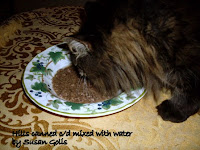Planning a diet for an overweight FIV (Feline Immunodeficiency virus) cat involves restricting the cats diet so that the cat does not nibble on food all day and changing the food from dry kibble to canned turkey food which is a low fat protein.
Sam
my FIV cat needs to shed some extra pounds. He is ten years old and weighs 12 pounds. Sam is set in his routine. He sleeps most of the day and plays with our
dogs a total of fifteen minutes daily. The rest of the time he is cuddling with
us on the sofa or sleeping.
In February 2012 I was told that Sam needed to go on a diet. He weighed 15 lbs and the veterinarian wanted him to weigh 10 lbs. In February I fed Sam Blue Buffalo spa selects a high protein chicken diet and gave him a combination of canned and dry kibble cat food.
Sam would quickly eat the canned food and then leave the rest; this is the food that he snacks on throughout the day. In the last eight months Sam's energy has decreased due to the FIV virus and he sleeps more which is why he is slow to shed those extra pounds. Older cats that are less active have a hard time loosing weight.
Sam would quickly eat the canned food and then leave the rest; this is the food that he snacks on throughout the day. In the last eight months Sam's energy has decreased due to the FIV virus and he sleeps more which is why he is slow to shed those extra pounds. Older cats that are less active have a hard time loosing weight.
My
veterinarian explained that overweight or obese cats are at risk of feline
health conditions; heart disease and diabetes are the two main health concerns.
Sam has a weakened immune system so I must be strong and not give into him when
he begs for food.
Diet Plan for Overweight Cat
Starting today my cats daily diet routine is going to change. The plan is to restrict my overweight cats freedom from eating whenever he wants. Sam loves to eat and in past when I took away his food in the afternoon he was getting into the kitchen cabinets and trying to scavenger food from the dogs bowl.
My cats new diet consists of a low calorie turkey canned food, that is high in protein. His food is Hills prescription diet; c/d. This is a maintenance food and it is good for a mature cat’s bladder. He will be eating canned cat food only.
Diet Plan for Overweight Cat
Starting today my cats daily diet routine is going to change. The plan is to restrict my overweight cats freedom from eating whenever he wants. Sam loves to eat and in past when I took away his food in the afternoon he was getting into the kitchen cabinets and trying to scavenger food from the dogs bowl.
My cats new diet consists of a low calorie turkey canned food, that is high in protein. His food is Hills prescription diet; c/d. This is a maintenance food and it is good for a mature cat’s bladder. He will be eating canned cat food only.
Dietary portions will be adhered to. Sam will eat 1/2 of his daily required food portion in the morning and 1/2 in the evening. There will be no snacking on the all-day food bowl and no more cat treats.
Along with his diet food plan he will begin an exercise routine. I will be playing with him with his Da-bird, a feather bird on the end of stick. Sam likes this toy and is always eager to play. To encourage Sam to stretch more I am going to spray his scratching post with catnip.
Tips:
Before starting a diet examine your cat to determine if they are overweight. Do this by trying to feel for their ribs. If you can feel the indentation of the ribs then your cat is of normal weight. If you can feel a thickness around the ribs then this is a sign that your cat is overweight.
Make an appointment with your veterinarian to determine if your cat has an eating disorder or if your cat has an illness. The veterinarian will do a wellness blood screen that will check for thyroid, blood sugar levels and they will check for heart disease and diabetes.
Your veterinarian will advise you of their findings. If your cat’s laboratory results are fine and do not indicate a health condition then your veterinarian will recommend that your cat lose weight and provide you with a diet plan.
Refrain from overfeeding your cat. Feed a six pound cat 3/4 to 1/2 cup of food daily. A 10
lb cat should be fed 1/2 to 3/4 cup of food daily. A 14 lb cat should be
fed 3/4 to 1 cup of food daily.










